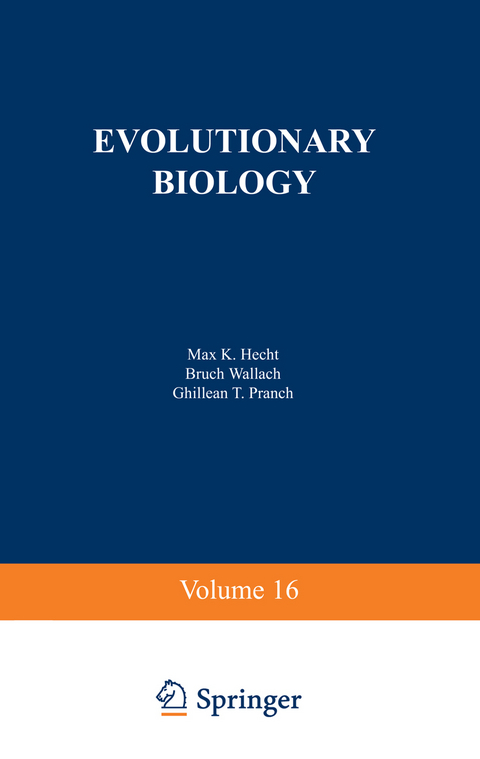
Evolutionary Biology
Springer-Verlag New York Inc.
978-1-4615-6973-2 (ISBN)
Sixteen volumes and one supplement have now appeared in the series known as Evolutionary Biology. The editors continue to seek critical re views, original papers, and commentaries on controversial topics. It is our aim to publish papers primarily of greater length and depth than those normally published by society journals and quarterlies. The editors make every attempt to solicit manuscripts on an international scale and to see that every facet of evolutionary biology-classical or modern-is cov ered. Manuscripts should be sent to anyone of the following: Max K. Hecht, Department of Biology, Queens College of the City University of New York, Flushing, New York 11367; Bruce Wallace, Department of Biology, Virginia Polytechnic Institute and State University, Blacksburg, Virginia 24061; Ghillean T. Prance, New York Botanical Garden, Bronx, New York 10458. The Editors vii Contents 1. Darwinian Selection of Self-Replicating RNA Molecules 1 Christ(~r K. Biehricher Introduction . . . . . . . . . . . . . . . . . . . . . . . . . . . . . . . . . . . . . . . . Replication of Virus RNA in Vitro. . . . . . . . . . . . . . . . . . . . . . . . 2 Extracellular Darwinian Experiments. . . . . . . . . . . . . . . . . . . . . . 5 Characterization of the QI3 Replicase. . . . . . . . . . . . . . . . . . . . . . 9 Nonviral RNA Templates of QI3 Replicase. . . . . . . . . . . . . . . . . . II The Mechanism of RNA Replication . . . . . . . . . . . . . . . . . . . . . . 14 Initiation of Replication and Template Specificity . . . . . . . . . . . 14 Mechanism of Replica Chain Elongation. . . . . . . . . . . . . . . . . . 17 Termination of Replication. . . . . . . . . . . . . . . . . . . . . . . . . . . . 19 Replication of RNA Variants . . . . . . . . . . . . . . . . . . . . . . . . . . 21 TheQuasispecies . . . . . . . . . . . . . . . . . . . . . . . . . . . . . . . . . . . . . 23 De NOl'O Synthesis of Self-Replicating RNA. . . . . . . . . . . . . . . . . 27 The Mechanism of Selection . . . . . . . . . . . . . . . . . . . . . . . . . . . . 32 Selection in the Exponential Growth Phase. . . . . . . . . . . . . . . . 32 Selection in the Linear Growth Phase. . . . . . . . . . . . . . . . . . . . 35 Conclusions . . . . . . . . . . . . . . . . . . . . . . . . . . . . . . . . . . . . . . . . 41 Appendix I. Replication. . . . . . . . . . . . . . . . . . . . . . . . . . . . . . . . 42 Appendix II. The Quasispecies. . . . . . . . . . . . . . . . . . . . . . . . . . . 43 Appendix III. Selection under Various Conditions . . . . . . . . . . . . 44 References . . . . . . . . . . . . . . . . . . . . . . . . . . . . . . . . . . . . . . . . .
1. Darwinian Selection of Self-Replicating RNA Molecules.- Replication of Virus RNA in Vitro.- Extracellular Darwinian Experiments.- Characterization of the Qß Replicase.- Nonviral RNA Templates of Qß Replicase.- The Mechanism of RNA Replication.- The Quasispecies.- De Novo Synthesis of Self-Replicating RNA.- The Mechanism of Selection.- Conclusions.- Appendix I. Replication.- Appendix II. The Quasispecies.- Appendix III. Selection under Various Conditions.- References.- 2. Evolution of Enzyme Catalytic Efficiency and Adaptive Inference from Steady-State Kinetic Data.- Catalytic Efficiency.- Catalytic Significance of the Michaelis Constant.- Evolution of Catalytic Efficiency.- Dynamics of Enzyme Catalytic Evolution.- In Vitro Approximation of the in Vivo Environment.- Experimental Design and Statistical Analysis of Kinetic Data.- Conclusions.- References.- 3. The Role of Single-Gene Mutations in the Evolution of Flowering Plants.- Reproductive Structures.- Growth Habit.- Vegetative Structures.- Sexual Reproduction.- Discussion.- References.- 4. Maintenance of Genetic Variation in Plant Populations.- Models.- Conclusions.- References.- 5. Evolutionary Genetics and the Genetic Control of Morphogenesis in Flowering Plants.- Genetic Control Mechanisms.- A Genetic Approach to Plant Development.- Geometrical Considerations.- Epigenetic Processes.- Indirect Action of the Regulating Genes: The “Hairy Achenes” System of Microseris.- The Independence of the Responding Genes.- Heteroblastic Development.- The Canalization of Numbers of Parts: Principles.- Canalized Numbers of Parts: The Mechanism.- The Genetics of Canalized Numbers of Parts.- Conclusions.- References.- 6. Phenotypic Evolution in Microfossils.- Theoretical Background.- Phenotypic Variation and thePaleoenvironment: The Case of the Cretaceous Foraminifer Afrobolivina afra.- Quantum Evolution in Afrobolivina?.- Phenotypic Variation and the Paleoenvironment: The Cretaceous Benthic Foraminifer Gabonita elongata.- Morphological Variation in a Species of Cytherella.- Species Transitions in Two Lineages of Cretaceous Ostracods.- Evolution in Planktonic Organisms.- Discussion.- Summary.- References.- 7. Monocotyledon Evolution: Characters and Phylogenetic Estimation.- Premises.- Reference Classification.- Characters.- Fossil Data.- Phylogenetic Estimates.- Summary.- References.- 8. Biochemical and Immunological Systematics of the Order Crocodilia.- Materials and Methods.- Results.- Discussion.- Conclusions.- Appendix I. List of Abbreviations Used in This Chapter.- Appendix II. Matrices of Albumin Net Spur Scores.- References.- 9. The Establishment of Novel Mate-Recognition Systems in Introgressive Hybrid Drosophila Populations.- Possible Experimental Approaches to the Study of Sexual Isolation.- Materials and Methods.- Multiple-Choice Tests Involving D. persimilis, D. pseudoobscura, phyps-1, and phyps-3.- Multiple-Choice Tests Involving D. persimilis, D. pseudoobscura, phyps-3, phyps-5, and phyps-9.- An Intermediate Behavior, or a Mixture of Flies with Two Differing Behaviors?.- Observable Improvement Occurring during the Development of New Mating-Behavior Phenotypes.- Discussion.- Summary.- References.
| Erscheint lt. Verlag | 12.10.2012 |
|---|---|
| Zusatzinfo | XIV, 500 p. |
| Verlagsort | New York, NY |
| Sprache | englisch |
| Maße | 152 x 229 mm |
| Themenwelt | Naturwissenschaften ► Biologie ► Evolution |
| ISBN-10 | 1-4615-6973-7 / 1461569737 |
| ISBN-13 | 978-1-4615-6973-2 / 9781461569732 |
| Zustand | Neuware |
| Haben Sie eine Frage zum Produkt? |
aus dem Bereich


